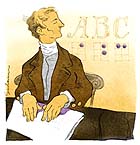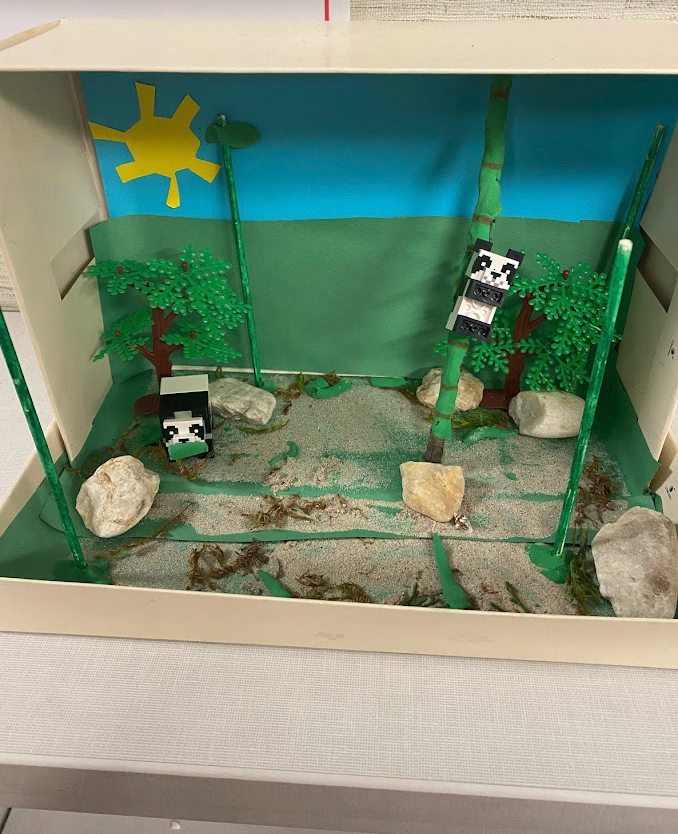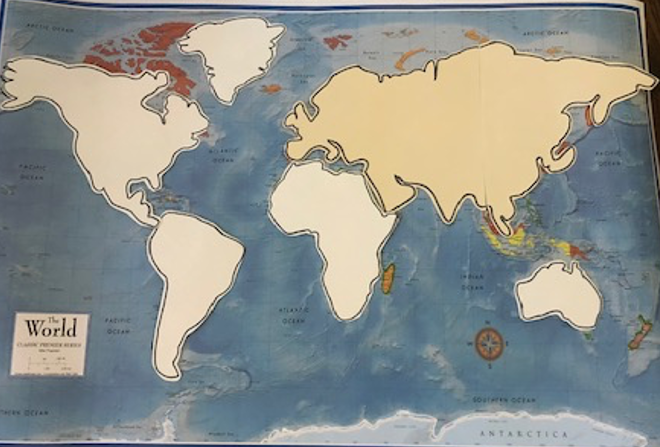By Sherrill Kushner, Special to The Los AngelesTimes
January 2005
Part 1: ‘The Story of Louis Braille’
In 1812, in the small village of Coupvray, France, 3-year-old Louis Braille played in his father’s harness shop next to the family’s house. His father was one of the best harness makers in the area. Mr. Braille also made reins, saddles and collars for the villagers’ horses. He cut strips of leather and punched holes in the leather with sharp tools. Louis had been warned that he was too young to play with the tools in the shop.
That day, Mr. Braille stepped outside the shop to help a customer. Louis thought he would try to punch a hole in a piece of leather just like his father did. He grabbed the tool and tried to push it through the leather. He didn’t have the strength of his father. He tried again, pushing harder. The tool slipped from his hand and flew up and into his left eye. Louis screamed with pain. His parents, two sisters and brother ran to help him.
They put a cloth over his eye. There was no hospital in Coupvray. The closest doctor was very far away. They took Louis to a woman in the village who used herbal medicines to treat injuries and sicknesses. She dipped a cloth bandage in a wet herbal solution and placed it on Louis’ eye. But his injured eye became infected and the infection spread to his other eye. Within a short time, Louis lost sight in both eyes and was permanently blind.
At that time, most people who were blind were helpless. They had to depend on others. Only the wealthy or those of a high position had any hope of getting an education or earning a decent living. Many ended up becoming beggars.
Tuesday: What would become of Louis?
Part 2: ‘The Story of Louis Braille’
The story so far: At age 3, Louis Braille became blind after playing with a tool in his father’s harness shop.
Mr. Braille carved a small wooden cane for Louis to help the boy feel things that were ahead of him when he walked. When Louis was 6, a new priest came to town. The priest gave Louis lessons for a year, but Louis wanted to go to the village school with the other children. So a classmate agreed to pick him up each morning and lead him to school. Louis listened to the teacher and memorized what he heard. Even though he couldn’t read or write, he was the best student in the class. He studied there for three years.
At times Louis was frustrated because he could not read or write. The priest and the principal thought Louis would do better in a school for blind students. There was only one school like this in France — the Royal Institute for Blind Youth. It was in Paris, 25 miles away. Louis’ parents were reluctant to let him go away from home. He was only 10 and the school was very expensive. The priest persuaded his parents to apply. The school accepted Louis and even paid for him to go to class and live there.
The school was in a rundown old building. It was damp and dark, and the students were given very little food. After his classes, Louis learned to play the cello and the piano. He couldn’t read music, but he memorized the notes. Louis was looking forward to learning to read. Unfortunately, there were very few books available for blind students. They were printed on heavy, waxed paper. The letters were formed by pressing the paper onto pieces of lead that were shaped like the letters of the alphabet. This process was called embossing. The books were very heavy. One sentence could take up a whole page. Louis learned to run his fingers over the pages so that he could feel each letter. It took a long time to read this way. By the time he got to the end of a sentence, he would forget the words at the beginning.
Wednesday: Was there a better way to make books for blind readers?
‘The Story of Louis Braille’ Part 3
The story so far: Louis Braille studied at a school for blind students where the few books made for the blind were heavy and hard to read.
A retired French army captain, Charles Barbier, came to visit the Royal Institute for Blind Youth. He had invented a way for soldiers to send messages to each other at night without needing light or having to talk. If they had to use light or make noise, the enemy could spot the soldiers and shoot at them.
With a pointed tool, the captain punched dots and dashes into heavy paper. The dots and dashes represented different sounds. These marks were combined to form words and could be read without light or sound. But the soldiers found it too difficult to use. The captain thought blind students might be able to use it instead.
The students tried to read some of the messages but they also found the system complicated to learn and difficult to use. Many dots were required to represent a single word. Still, it took up less space than the existing process of embossing actual letters from the alphabet.
Louis was excited about this new way to read. He spent most of his free time learning the system. He knew it would have to be made simpler. He also had to find a way to include numbers and punctuation. So in his spare time and late at night, Louis worked hard to improve the captain’s system. With a pointed instrument called a stylus and a wooden writing board with paper, Louis continued working on it. After two years of work, when Louis was 15, he finally created a new code. It was easier to learn and quicker to read.
Louis brought it to the new director of the Royal Institute. To test the code, the director read a newspaper article aloud. Louis punched the stylus into the paper to write down what the director said. When the director finished, Louis ran his fingers over the raised dots and repeated back the exact words read by the director. The director was very impressed.
Thursday: Would other students be able to use Louis’ new code?
Part 4: ‘The Story of Louis Braille’
The story so far: Louis Braille spent his spare time at his school for the blind trying to improve on a night writing system so blind students could learn to read and write.
Louis’ classmates at the Royal Institute for Blind Youth tried out his new alphabet system. They were delighted to find how well it worked. Now they could take notes in class. Memorizing long class lectures wasn’t necessary any more. They didn’t need anyone’s help to read or write.
Louis was very happy that his classmates liked his new code, but he wanted other blind people to be able to use it too. The school director wrote to the French government and asked if Louis’ dot alphabet could be made the official system of writing for the blind.
In the meantime, Louis became an assistant teacher at the institute. His classes were very popular. He also spent a lot of time copying books into his code. He even added symbols so that blind musicians could read and write music. He eventually had a book published describing his new code.
Louis also learned to play the organ. He played so well, he worked as an organist at a nearby church. He soon became a full-time teacher at the institute. In 1834, Louis demonstrated his dot alphabet at the Exhibition of Industry held in Paris . All sorts of inventions were shown there. He took notes as people spoke and then read back what was said.
The French king was at the exhibition and saw Louis’ invention, but he didn’t make it the official language for the blind. The king also didn’t offer any money to create books in the dot alphabet.
Friday: Would Louis’ invention ever be used to help all blind people?
Part 5: ‘The Story of Louis Braille’
The story so far: Louis Braille created a new dot alphabet for his blind classmates.
When Louis returned from the Exhibition of Industry in Paris , he was sad that his invention wouldn’t be available to other blind people. In the last few years he had occasionally felt tired. He also sometimes had a bad cough and fever. He grew sicker. His doctor told him he had consumption, or what we today call tuberculosis. At that time the only remedy for this disease was fresh air and rest.
Louis taught less and spent time outside. He continued to improve the dot alphabet. He added the letter “w” so that his code could be used to write English. And he worked on creating math textbooks for blind students.
A new director came to the Royal Institute for Blind Youth and wouldn’t allow the students to continue using Louis’ new alphabet. The director was afraid that the students would become too independent and would no longer need the teachers who could see.
Louis was very disappointed. His health grew worse, and several times he went home to Coupvray to rest. He worked on writing books and music in his dot system. He died in Paris in 1852.
Two years later, the French government approved the dot system. It was called “Braille” after Louis’ last name. In 1878, the World Congress for the Blind voted to make Braille the system of reading and writing for all blind people worldwide. With the help of the United Nations, Braille has been adapted to almost every known language.
Many books are available in Braille. Some are created by typing the words on a computer that translates them into Braille. They are then transferred onto paper or metal plates for use on a press.
Louis Braille’s house in Coupvray , France, is now a museum. On the wall a plaque says that Louis Braille was born in the house and that he invented the system of writing in raised dots for the blind. It also says, “He opened the doors of knowledge to all those who cannot see.”
Additional Resources
To see the Braille alphabet, go to https://www.nbp.org/ic/nbp/about/aboutbraille/alphacard.html.
Braille Bug features an assortment of games and activities for learning Braille that are both fun and educational. The website is for both sighted and visually impaired students in grades two through six. It also includes biographies of Helen Keller and Louis Braille.
Author’s note: The first book in braille was published in 1827. Since then millions of people who are blind or have low vision have continued to read, write and communicate through the six-dot system. To promote Braille literacy and recognize its inventor, Louis Braille, January is designated as Braille Literacy Month in honor of his birthday on Jan. 4, 1809 . The author thanks Carolyn Meyer, director of the Louis Braille Center in Edmonds, Washington, for fact checking this story.
- Dots for Families
- What I Shared with a Parent who Didn’t Know Where to Start
- Making Books Meaningful and Motivational
- Introduction to Braille Writing
- Portable Note Taking Devices
- Slate and Stylus
- Braille Embossers
- Braille Lessons in UEB
- How to Download and Use Perky Duck
- Families Learning Braille
- Technology for Children who are Visually Impaired
- Categories of Assistive Technology
- Selecting Computer Software
- Who’s Who in Braille
- The Story of Louis Braille
- Stories of Braille Users
- Anna’s Story
- Haylee’s Story
- An Update on Dots for Families and Stories of Braille Users
- Developing Children’s Braille and Literacy Skills
- Organizations and Companies




